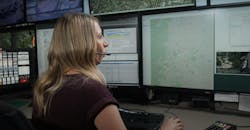RapidSOS banks on AI to boost emergency response
RapidSOS, an intelligent safety company that fuses life-saving data and communicates with more than 21,000 public safety companies, is banking on the capabilities of artificial intelligence to improve emergency response.
A $250 million, decade-long collaboration effort with public safety officials has resulted in RapidSOS Unite, a new platform unveiled by the New York City-based company that combines critical emergency data, multimedia feeds and tools like language translation and messaging into a unified platform.
The company says that the AI-powered platform integrates with most call-handling and computer-aided dispatch applications, providing a comprehensive picture of emergencies while enabling advanced AI-assistive tools, multimedia streaming, and critical data from over half a billion connected devices.
RapidSOS CEO Michael Martin says public safety agencies have been working with his firm for nearly a decade to integrate critical emergency data from more than 540 million connected devices into a tool that can boost effectiveness and situational awareness for dispatchers and first responders.
Martin says RapidSOS Unite modules allow agencies and communities to customize it based on their scope and needs, whether it’s enhanced mapping using local GIS data, automated translation and transcription, integration into field responder applications and intelligence analytics, or forecasting and reporting for calls, text and digital alerts.
The Field Responder module extends the unified picture of an incident out to those responding. The Intelligent Analyst module unifies all data from each incident -- even those where the phone doesn’t ring, such as during an outage, IoT incidents, or hang-up calls -- into a unified reporting, analytics and forecasting application.
Also unveiled this week in beta is RapidSOS Harmony, which the company says is the first AI copilot for public safety. The technology, which integrates with the Unite platform, extracts key information from data feeds around an emergency, making it actionable for 911 and field responders within their existing software systems and operational procedures.
Initially, Harmony will synthesize key information from data feeds into one unified picture of an incident and automate the time-consuming, manual process for alarm calls to make actionable data available quicker with less human effort.
Harmony also extracts key insights from text and video data, including sentiment analysis, language translation, keyword alerting and video object detection to help 911 professionals.
RapidSOS says $250 million in research between the company and public safety agencies resulted in the large-language model behind Harmony.
To explain how the technology works, RapidSOS used the example of a major train derailment. Harmony would parse train consist information to identify which cars contain hazardous materials and immediately pull up relevant Emergency Response Guidebook (ERG) procedures for the specific chemicals.
Martin says AI technology won’t replace the “talent, ingenuity and professionalism” of public safety but it can serve as a “co-pilot” to automate mundane and redundant tasks and feed the most important inputs to dispatchers and responders.
Martin believes this tech stack is the answer to infrastructure challenges the U.S. faces with a bevy of 911 systems that are analog-based. He says funding is scant to update the technology, leaving the challenge to local law enforcement to figure out.
“So we’ve been on a 10-year journey to figure out how to partner with public safety to unify all that. And it's been the most amazing thing, just how the public safety community has partnered with us,” Martin told SecurityInfoWatch.
Martin notes that information overload has quickly become a problem for 911 communication teams facing major staffing shortages and needing to work efficiently. The company developed an AI model trained specifically trained on public safety data.
While excited about Harmony, Martin expects the technology iterations to improve its effectiveness, noting that it has drawn on the foundational data from more than half a billion emergencies that have taken place in the last six years. The models are built on authoritative data, not “hallucinations” from made-up answers that might emerge from off-the-shelf generative AI tools.
“Our AI copilot is probably still a middle schooler. It's learning, it’s good. It really wants to ace every test, but it will take some time,” Martin says. “We really use the term co-pilot in an aviation sense. The captain’s going to land the plane, no one else is doing that. The co-pilot’s job is to read all the periphery sensors and feed only the most important pieces of information into that skilled captain’s hands, so he or she is sticking that landing.”
Martin shared another example of how the technology will improve the performance of first responders – a car crash with injuries. The vehicle’s data system may know about the crash severity and possibly the number of passengers but knows nothing about the occupants’ conditions.
But if a passenger has a wearable or digital health device it may indicate the person has preexisting health conditions and is actively dying. In a rural area, there may be a limited amount of ambulances and there’s no way for dispatchers to know to escalate to other ambulances in the area or to notify emergency flight transport.
Martin says Harmony can stitch together the ecosystem so the accident location goes on the map, the blood type goes to the EMS team, HAZMAT information goes to the responding firefighters, and so forth, to improve situational awareness.
“For folks who want to participate in this, you could really help make a difference in outcomes with these local first responders,” he says.
John Dobberstein is managing editor of SecurityInfoWatch.com and oversees all content creation for the website. Dobberstein continues a 34-year decorated journalism career that has included stops at a variety of newspapers and B2B magazines.
About the Author
John Dobberstein
Managing Editor/SecurityInfoWatch.com
John Dobberstein is managing editor of SecurityInfoWatch.com and oversees all content creation for the website. Dobberstein continues a 34-year decorated journalism career that has included stops at a variety of newspapers and B2B magazines. He most recently served as senior editor for the Endeavor Business Media magazine Utility Products.


